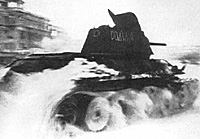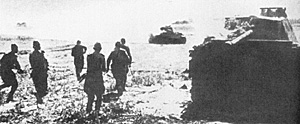 The cutting edge of the Red Army in Enemy At The Gates comprises the Tank and Mechanized Corps. These formations are composed of sub-units ranging in size from
battalions through brigades. Most corps enter play at or near full strength. They seldom stay this way for long.
The cutting edge of the Red Army in Enemy At The Gates comprises the Tank and Mechanized Corps. These formations are composed of sub-units ranging in size from
battalions through brigades. Most corps enter play at or near full strength. They seldom stay this way for long.
No matter how skilled the Soviet player, or how unlucky the German, these premier combat mechanized formations are going to take losses. A key to successful Soviet play is understanding how and when to rebuild corps after casualties occur.
Soviet methods will differ considerably from those of the German player. The reason for this is Rule 3.5, "The Stalin Order." This rule requires that all the sub-units of a particular formation be either stacked together, or adjacent to each other, at the end of the initial Movement Phase. Since the German player is not burdened by this rule, he is able to keep his Panzer and Motorized divisions continuously in action, and to feed them replacement sub-units as they are rebuilt on an individual basis. The impact of this rule is to force the Soviet player to choose one of three options in rebuilding damaged combat mechanized corps.
- First, he can withdraw the surviving sub-units to a position on or adjacent to the rear area HQ acting as the replacement depot.
- Second, he can move the HQ acting as the replacement depot closer to the front and keep the surviving sub-units forward.
- Third, he can, at a certain point, burn up the remaining subunits and then rebuild the entire formation in a single turn.
Upside and Downside
Each of these options has an upside and a downside, but if he fails to select any of them, the Soviet player will end up paying an excessive cost in SPs to fuel the remnants of shattered formations. Additionally, as their strength declines, these wounded formations become less able to accomplish their missions. In effect, you end up paying the same SP costs for smaller results. Let's examine each of these options in detail.
Witdraw
Withdrawing damaged front line formations to the rear is not as easy as it sounds. Chances are that, if the formation took losses in the first place, it did so against strong opposition. To withdraw in the face of such opposition is risky and can invite a counterblow. At the very least, you will need to plug the hole created by the withdrawal with other units.
Then there are the questions of time and fuel. The inadequacy of the Soviet rail net for most of the game often means that the HQ acting as a replacement depot will be located far to the rear. This will compel the withdrawing formation to spend SPs for fuel simply to be able to move to the HQ. Again, this takes time in a game that constantly pressures the Soviet player to maximize productive use of his forces. The bottom line is that this is a difficult, expensive and time consuming option to execute. <>Moving HQs
Moving HQ's acting as replacement depots forward appears, on the surface, to avoid the problems encountered in the first method. It enables wounded formations to remain in action while Pax and Eq replacements accumulate. As they slowly make their way forward, the subject HQ can continue to perform other functions, such as broadcasting supply. While this approach is less cumbersome than the first option, several significant problems remain.
Foremost among these is, once again, the pressure of time. In many cases the rail net does not run directly to the area of the front where the replacement depot HQ is located. Therefore, Pax and Eq reinforcements will have to march to their destination, which they do at an alarmingly slow pace. Frequently, by the time that they arrive, the front has either moved forward and/oradditional losses havebeen suffered.
These factors will prolong the replacement process and will force at least a temporary withdrawal of the damaged formation once sufficient replacements have finally been accumulated at the proper spot. The larger the formation being restored to full strength, the greater the complexity and potential negative impact of these first two methods.
Burn
The third option seems to best maintain the tempo of offensive operations that the game imposes on the Soviet player. Here's how it works.
The Soviet player should identify a limited number of strategic directions along which his main forces will operate. These strategic directions are, in effect, the general routes that he will take toward his key geographic objectives. Once selected, an HQ acting as a replacement depot should be located within each one. These depot HQs should be on or near a rail hex linked to the appropriate entry areas for reinforcements. As Pax and Eq replacements become available, they should be transported by rail to the subject HQ. If possible, hide the location of these depot HQ's from your enemy by placing a low mobility combat unit atop them. Above all, conserve arriving Pax and Eq replacements. Do not immediately spend them; accumulate them for future use instead.
Until a particular combat mechanized formation suffers 50% or greater losses, it still makes sense to preserve it in being and to use it as part of your larger efforts. Once it reaches this threshold, however, keeping it alive is no longer justified. Instead, take the remaining sub-units and send them racing forth on high-risk missions. The purpose of this approach is to lose them intelligently. Go after that enemy airfield well behind the lines. Attack that PanzerKorps HQ in the center of the enemy position. Cut that rail hex supporting his southern wing. In short, put the surviving sub-units in positions of great peril but equally great reward.
This sort of action will force the German player to react. He will probably concentrate enough force to kill off your daring sub-units. If he fails to do so, they wil probably die from supply attrition anyway. That's OK. In the meantime, they may actually put some real hurt on the enemy. Once they are dead, you get to rebuild them. This is the fun part.
 If you have accumulated enough replacements at your depot HQ, you can now rebuild the entire formation at a different point on the map. You can time this to coincide with launching a
mapr offensive in the strategic direction of your choice. Suddenly, a formation that was destroyed south of Stalingrad is rebuilt near the northern map edge. It might have otherwise taken several turns, and a lot of fuel, to march the same formation from its starting point to
the spot upon which you rebuild it. This also has a nice effect on German morale. On one turn he feels great about kiUing off your formation; on the next it reappears intact at a critical point on the map!
If you have accumulated enough replacements at your depot HQ, you can now rebuild the entire formation at a different point on the map. You can time this to coincide with launching a
mapr offensive in the strategic direction of your choice. Suddenly, a formation that was destroyed south of Stalingrad is rebuilt near the northern map edge. It might have otherwise taken several turns, and a lot of fuel, to march the same formation from its starting point to
the spot upon which you rebuild it. This also has a nice effect on German morale. On one turn he feels great about kiUing off your formation; on the next it reappears intact at a critical point on the map!
It may seem petty and historically inaccurate to kill off damaged formations in this manner. Actually, it is neither. It is not petty because "kamikaze" raids may produce significant results. Killing off a vulnerable HQ may put a large portion of the German front out of supply. Overrunning an airbase may destroy a vital part of the Luftwaffe. If you select high-value targets for your raids, you are simply exercising the risk/ reward decision-making that is central to the game.
Historical Doctrine
Furthermore, such methods conform to historical Soviet doctrine. Throughout World War 2, the Red Army lacked the sophisticated logistics commonly found in western armies. There was never enough transport to move all the supplies needed for front-line units, much less to carry raw recruits and spare parts. Actual Soviet practice was to burn up units and to then either totally reconstitute them in the rear or to merge their shattered remnants into other units. In fact, the award of Guards status to units frequently occurred when the units were being completely rebuilt after having been destroyed. As for the historic use of "raids," the Soviets were famous for them. One of the reasons for the success of von Manstein's "Backhand Blow" at Kharkov was the overextension of the Red Army combat mechanized corps south of the city. They had been engaged in an all-out drive to the Dnepr, despite the fact that they were severely reduced in strength.
The keys to using this third method to greatest effect are as follows:
-
1. Preposition HQs acting as replacement depots in the most advantageous spot.
2. Accumulate replacements at these depot HQs.
3. Mask the locations of these depot HQs and replacements.
4. Use your combat mechanized formations in a way designed to conserve their strength until their losses exceed 50%.
5. When sufficient replacements have been accumulated to rebuild them, send the surviving remnants on high-risk death rides against high-value targets.
6. Rebuild them, in their entirety, at the depot HQ closest to their next mission.
Use of these tactics will keep the German unsettled and will help you to shift forces to where they are needed with a minimum of time and fuel. Finally, death raids give the Soviet the chance to play recklessly every now and then. This is a thrill that he will otherwise seldom experience, since his mission requires the careful husbandry of his forces.
Back to Table of Contents -- Operations #28
Back to Operations List of Issues
Back to MagWeb Master List of Magazines
© Copyright 1998 by The Gamers.
This article appears in MagWeb (Magazine Web) on the Internet World Wide Web.
Other military history articles and gaming articles are available at http://www.magweb.com